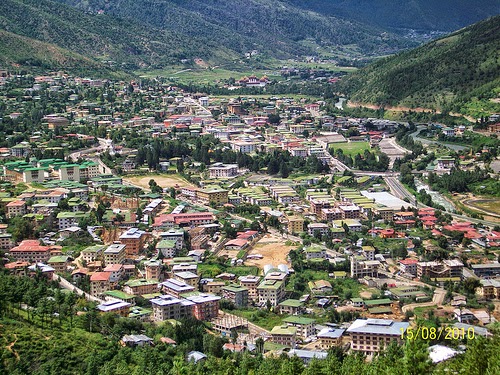 |
| Buddha Dordenma Statue (Front Elevation) |
Kuensel
Phodrang is the ruin palace of 13th Druk Desi, Sherab Wangchuk and
now it is altered into the palace of Buddha Dordenma statue, facing south Thimphu
valley. The Buddha statue is stands as one of the world’s largest statues situated
in Bhutan with a height of 169 feet or 51.5 meters. The world’s largest statue
will house more than one lakh of Toenpa Dordenma statue painted gold. The
statue is constructed on the hill of Changbangdo facing south Thimphu valley
and it’s visible from any places in Thimphu. Today, this site has been much
visited sites in Thimphu for recreation purposes or for viewing the entire
Thimphu city.
 |
| Kuenselphodrang Nature Park |
Kuensel
Phodrang Nature Park was inaugurated in 2011 and opened for the public in order
to recreate their tiredness and exhausts of working hard. The Park surrounds
the Buddha statue. Every day, more than hundreds of visitors visit the place
along with their families, relatives, friends, and loved ones. Tens and
hundreds of vehicles ply to the place to offer prayers for all sorts of
blessings for the future, to rejoice the outcome of their hard work, enjoy the
crystal clear view of Capital City, to celebrate meeting with friends after
long time, to treat loved ones with beautiful vicinity of the park under the eyes
of Buddha, make commitment and promises for the near future, and other reasons
too.
In
the evening, after the office hours and before nightfall, the people drive in
their own utility cars and reserve cabs to ply to the place. The visitor
ranging from high officials and low level officials, old aged and youngsters,
rich and poor, and other classes of people calmly and serenely visit the place.
The students after the long hours of tiring classes for a week or two, visits the
place to recreate their exhausted mind. Some few students silently go into the
forest with books and study there for whole day during weekends and holidays.
 |
| Back elevation |
During
Duezang or auspicious days, the family and relatives, friends and loved ones trips
to the site to offer their prayers to benefit themselves and all the sentient
beings as a whole. Coming to the couples, they take excursion to the spot to
make promises under the nostril of Buddha Dordenma statue. They also hold each
other’s hands and circumambulate or walk around the statue. When the couples
make promises and offer prayers for the future to come, some people offer
butter lamps and feasts.
Apart
from local visitors, today the site has been one of the tourist attraction
places in Thimphu valley. The tourist visiting the country by any means, visit
the place to view the scene of Thimphu city and also offer prayers. Most of the
tourists snap the photo along with Toenpa Dordenma statue. The tourists staying
in hotels and resorts in Thimphu voyage to the place to vision the night view
of Bhutan’s capital city.
 |
| Side Elevation |
Over
the year, the place has been much cherished and exciting place in Thimphu to
view the capital city. Prior to this place, the Sangaygang above Motithang has
been tourist spot and local visiting place to view capital city. The people
staying in Thimphu visit the place every day. The people coming from other
districts in the country has keen interest to journey to the place in order to
take photographs either with Capital city or Buddha statue.
There
is no other option to ply to the site, except if we take walk from Changbangdo.
Our journey starts from lower Chang-gaydaphu which is commonly known as
Kalabazar right above Jigme Dorji Wangchuck National Referral Hospital
(JDWNRH). It is ten minute drive from main town. The road heading to the site
is wide enough and black topped which make our journey comfortable and
contended.
 |
| Bird Eye view of Thimphu City from Kuenselphodrang |
 |
| Road heading to Kuenselphodrang |
When
we reach to the site, we can glimpse the fully furnished statue seated on the
three storied building visage the South Thimphu valley. The work is still under
process. Though, the construction of Buddha Statue is completed but the three
storied temple beneath the statue where Buddha is seated is not yet completed.
The one lakh statue of Toenpa Dordenma is installing in the temple along with
other thousands of statues.
Visit
the place to rejoice the life under the eyes of Toenpa Dordenma.
 |
| Complete Buddha Dordenma |

